Indoor-led grow lights have evolved a lot in the last few years and cannabis growers are continually in search of the perfect grow lights for them. Filling big grow tents and grow rooms with efficient light for plants to absorb without massive heat had always been a challenge for home growers on the medium and big scale, and for commercial growers as well.
We want to introduce the Mars Hydro FC 6500, a LED grow light panel that helps growers take a leap in their growth performance and yield without some of the usual drawbacks. It replaces 1000-watt HPS lights with much more efficiency and less heat and it also outperforms many LED panels with the same wattage advertised.

Key concepts to evaluate grow lights
First, here are some key concepts briefly explained for understanding/refreshing how to evaluate a grow light and know if it’s the right choice for your needs. Perhaps you’ve seen terms such as PPFD, light efficiency, light spectrum, yield comparison, and others but do not know exactly how to apply them or you are still confused by some light charts.
This article summarizes those concepts and applies them to the Mars Hydro FC 6500, a really powerful LED panel that meets the expectations of many experienced and demanding growers.
Light quantity (intensity) and quality (spectrum)
Plants sense and use light in a different way than humans and other animals. Plants can sense light intensities, light quality, light direction, and light duration through cells called photoreceptors. Light is the energy source for plants and there’s a specific spectral range that plants use to make photosynthesis, it’s called PAR (Photosynthetically Active Radiation).
Light Quantity (Intensity)
The units of measurement for usable light for plants to do photosynthesis (PAR) are PPF and PPFD. To answer the question of “how much light do your plants receive and use”, we talk about PAR and PPFD.
Photosynthetically active radiation (PAR) is the spectral range of light (solar radiation) from 400 to 700 nanometers that plants are able to use in the process of photosynthesis.
Photosynthetic Photon Flux Density (PPFD) measures the number of photons (how much light) from a light source at a given time that reaches a specific area.
In other words, PPFD measures the amount of PAR light that the canopy of your crop receives per second in a square meter.
Photosynthetic Photon Flux Density (PPFD) is measured in micromoles per square meter per second (μmol/m2.s).
Depending on the stage of growth, the best PPFD for cannabis plants varies.
For the cannabis plant growing stages, the PPFD recommended for explosive growth and big yields are
| STAGE | PPFD recommended |
| Seedling | 100 – 300 μmol/m2.s |
| Vegetative | 400 – 600 μmol/m2.s |
| Flowering | 800 – 1,000 μmol/m2.s |
The Mars Hydro FC 6500 can deliver this PPFD (and more) uniformly across the canopy for maximum growth and yield. Depending on the distance between the canopy and the lights, this LED panel can meet the needs of every stage at every corner of a grow tent of 5’ x 5’ (150cm x 150cm) for the vegetative stage and the flowering stage.
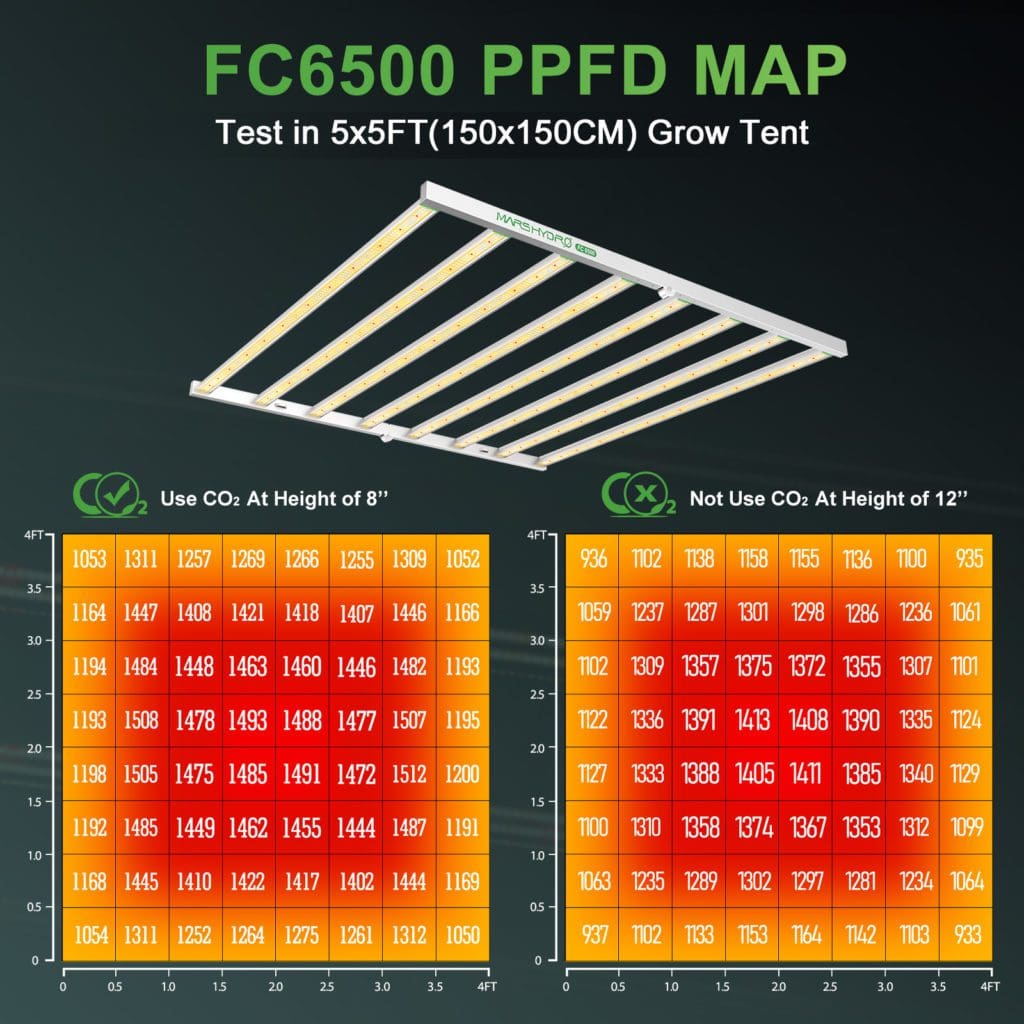
The Mars Hydro FC 6500 reaches every corner of the grow space with the ideal PPFD for the flowering stage maximizing yields. Other LED panels concentrate most of the PPFD in the center but leave the corners with very low light intensity, which results in smaller and weaker plants in the corners. This is important to home growers but crucial for commercial growers and big facilities with more than one panel.
Cannabis has an increasing rate of photosynthesis up to a PPFD of 1500 μmol/m2.s. In commercial facilities and big grow spaces, the supplementation of CO2 is needed to achieve these values. The Mars Hydro FC 6500 has PPFD values in the range of 1000-1500 μmol/m²/s throughout the effective coverage area, given by the multi-light bar design and dense distribution of light chips.
For the flowering stage, PPFD of 1000 μmol/m2.s across the canopy, makes a huge difference in yield as it renders big buds with compact plants and huge colas. It also helps plants grow and maintain their aromatic and medicinal compounds such as cannabinoids, terpenes, and flavonoids. Many LED panels do not reach these PPFD numbers and cannot render the maximum possible yield, no matter the strain or how good your fertilizers are.
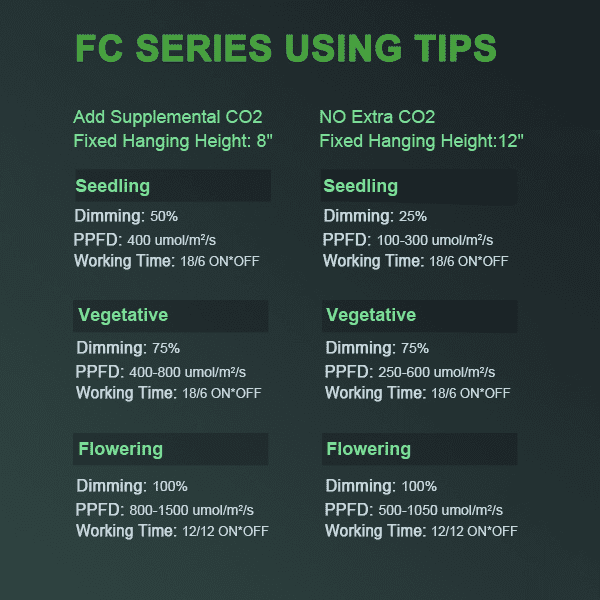
Without the minimum PPFD recommended, plants won’t grow as strong and big as they should and this diminishes yields.
PAR meters are used to measure PPFD but as they can be costly, there are estimated hanging heights for each panel to achieve the desired PPFD for each stage of the plant. Find the best grow light distance in the illustration called “FC series Using tips” below.
Light Quality (Spectrum)
The light spectrum has effects on photosynthesis and effects on plant shape and development. You can control plant height and how dense are the flower buds using the right light spectrum.
The enhanced Blue Spectrum (in the white light) promotes and accelerates vegetative growth. Blue photons of light control elongation and leaf expansion. The right fraction of blue light keeps plants compact and avoids unwanted elongation. Blue light also helps grow more tight buds as opposed to spaced-out flowers.
The enhanced Red spectrum boost crop yield and quality as it promotes efficient photosynthesis.
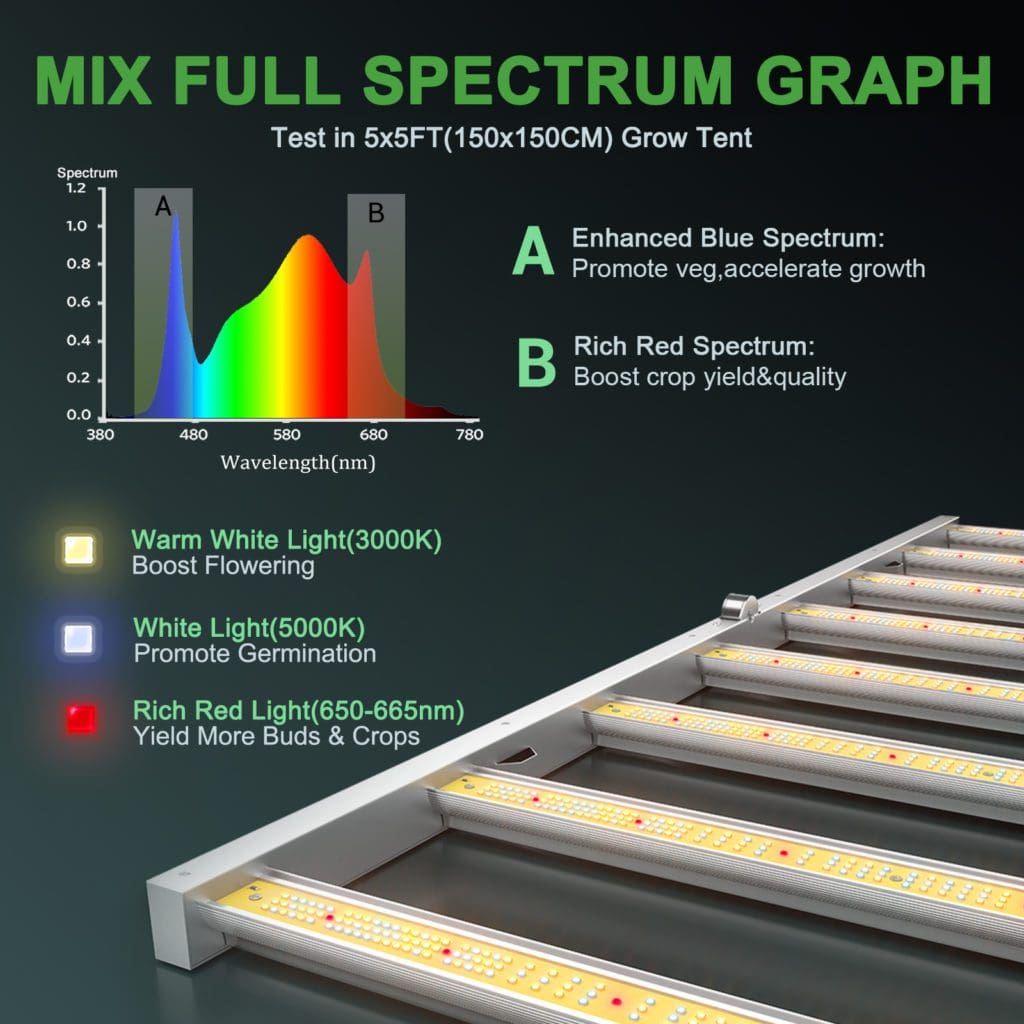
The Mars Hydro FC 6500 has a great sunlight-like spectrum which allows cannabis plants to grow at their best. The LED panels are equipped with Samsung warm white light (2800-3000K, 4800-5000K) chips and Osram RED light (660-665nm).
This red + white led combination makes the most efficient LED panels for cannabis growing.
Yield comparison
Mars Hydro FC 6500 works to render a yield of 3 g/watt with the right conditions for each stage in the grow room. As a comparison, HPS lights can give up to 1.5 g/watt in the best conditions, some blurple panels give up to 1.2 g/w in the same area.
Cannabis bud yield is proportional to light intensity. High light intensity in the flowering stage (800 – 1,000 μmol/m2.s) increases the harvest index and the size and density of the apical buds, meaning increasing quality.
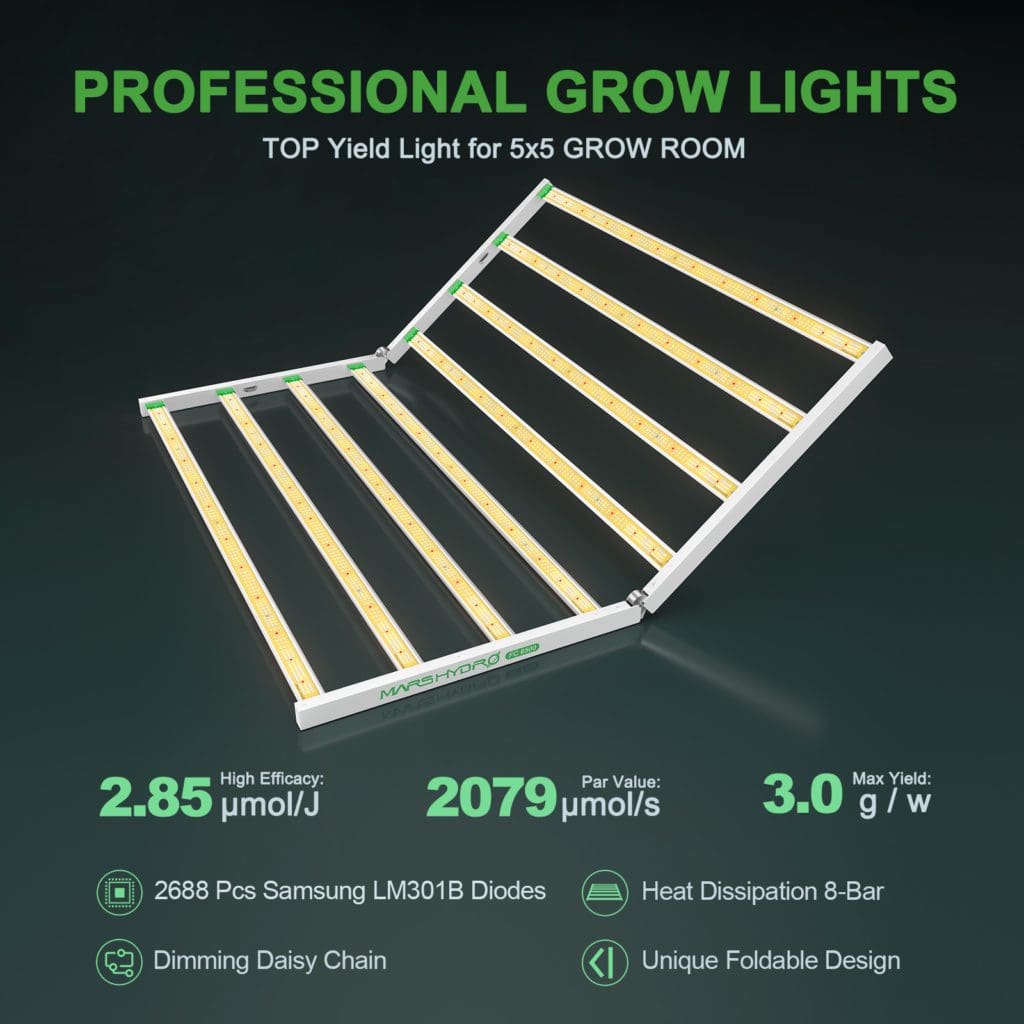
Efficiency
The key to efficiency is given by the Samsung chips for white light and Osram red light chips. The Mars Hydro FC 6500 has high-quality efficient LEDs Chips Samsung LM301B (white) and Osram 660nm LEDs chips (red). It measures a usable Photon Efficiency of up to 2.85 µmol/J. For comparison, the efficiency of HPS lights is 1.8 µmol/J and for Blurple panels, 1.6 µmol/J. This LED panel replaces 1000-watt HPS in light intensity but with higher efficiency.
The bill cost will be significantly lower and yields will be higher, meaning more flowers per dollar of electricity on average than HPS and many other LEDs with lower efficiency.
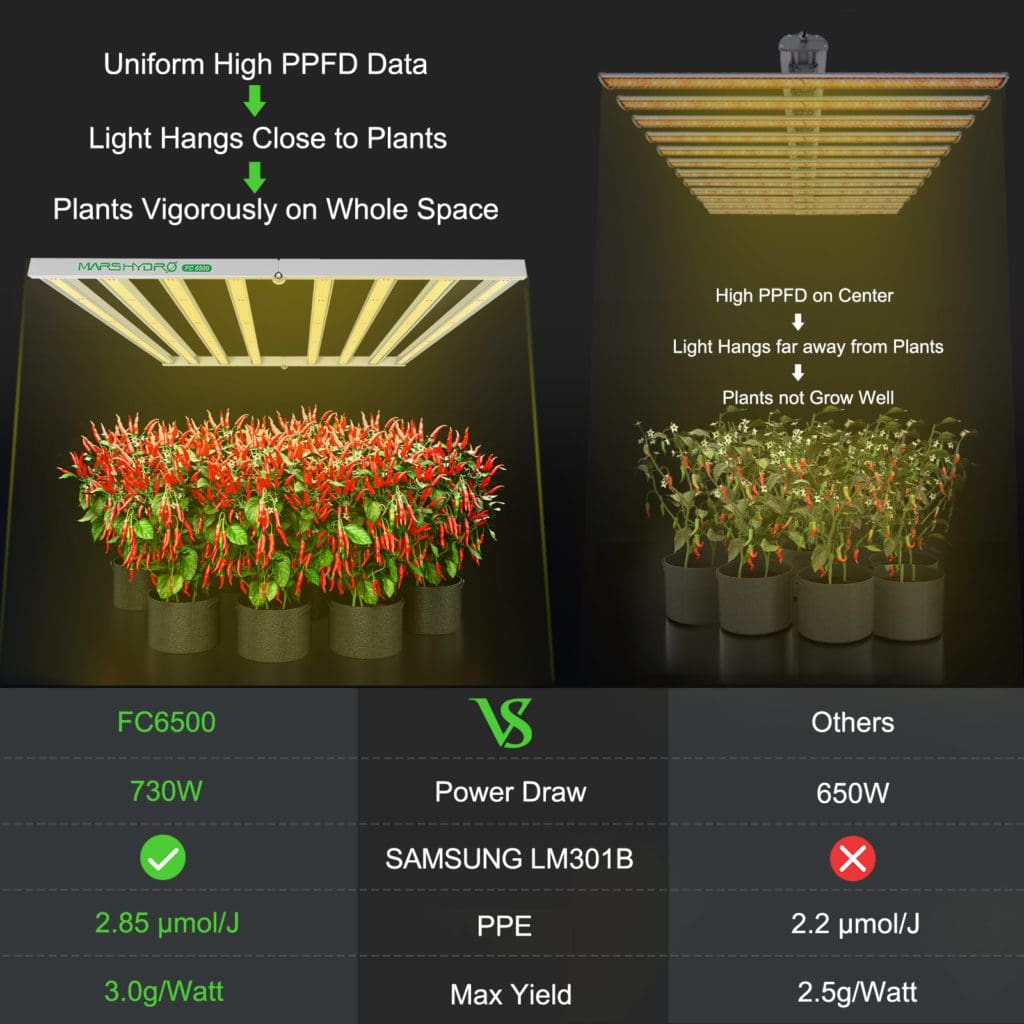
Also, the lifespan of an FC 6500 is 50,0000 hours+, as opposed to blurple panels with a lifespan of 10,000 hours.
Design
Foldable Design
We can appreciate a formidable design and yet very lightweight. The foldable design is a must for big LED panels and it makes it so manageable for delivery and storage as well. One person can make it work and set it up in no time.
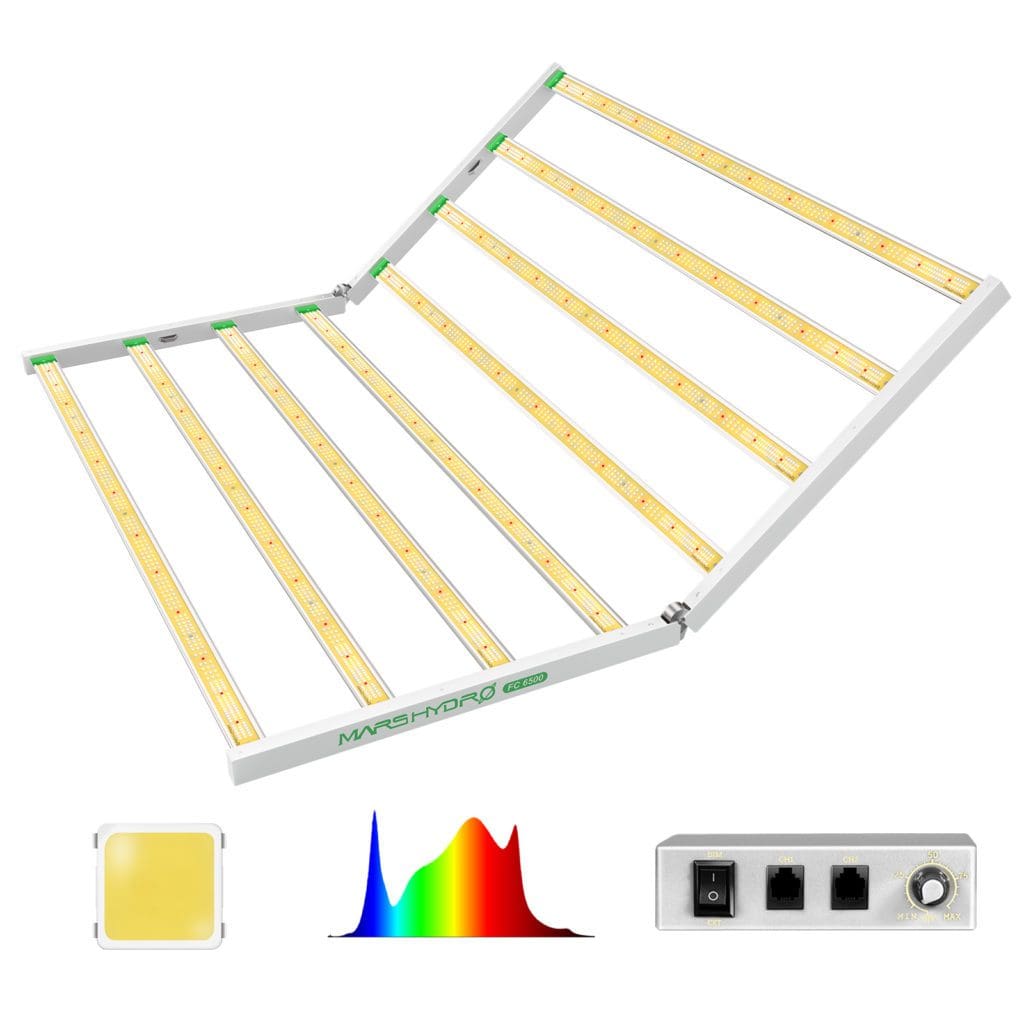
Daisy chain dimming function
For big grow rooms, you can daisy chain up to 30 Mars Hydro FC 6500 with a simple cable and control it through just one light, even using the dimmer function with all of them in a very easy way. This makes it a great choice for growing environments with dozens or even hundreds of plants with the same light intensity needs and it facilitates work.
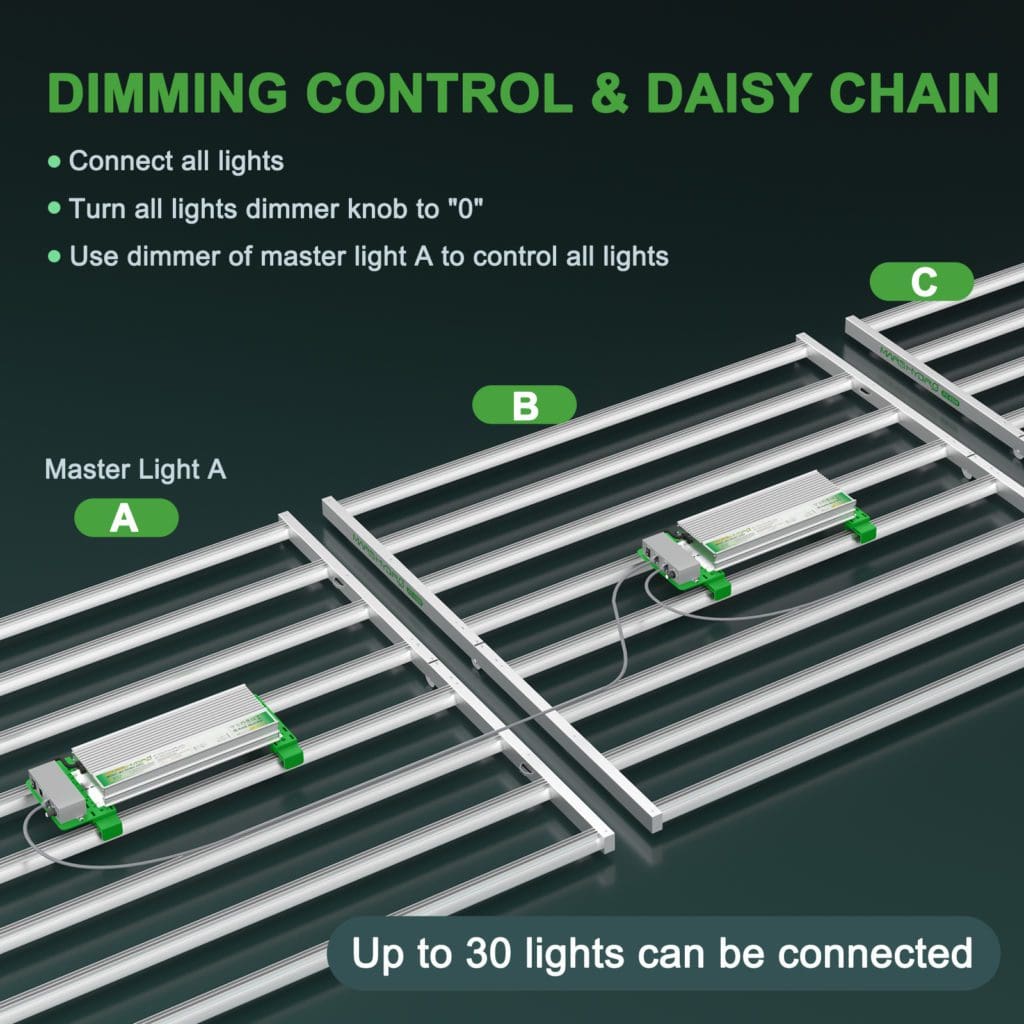
No-Fan Design, Aluminum Heatsink, and Removable Driver
This LED panel is so efficient it doesn’t need an extra fan, so no fan, no noise. The aluminum heatsink is thick and sturdy and renders optimal heat dissipation. It has a removable driver that allows you to put the driver outside if needed.
The whole FC 6500 is waterproof and dirtproof as well, with an IP65 it’s one of the most resistant LED panels for humid environments.
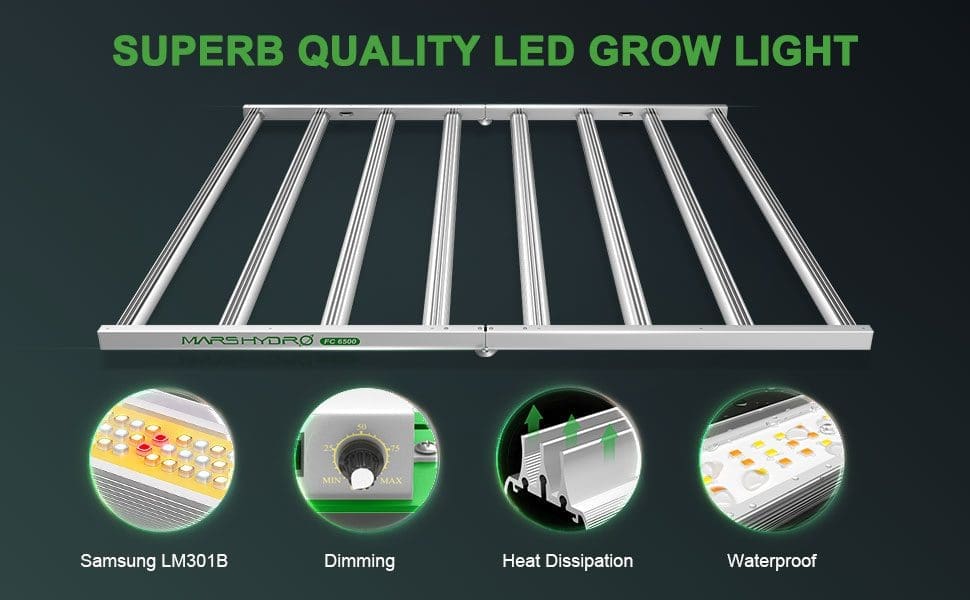
Vertical Farming
The Mars Hydro FC 6500 is perfect for vertical farming as it maximizes the grow space of stacked vertical and column vertical so you can grow more plants in the same environment. As the FC series is equipped with optimal passive cooling heatsinks it works great even at short distances from the canopy.


The post Mars Hydro FC 6500 Review appeared first on Grow with Jane.





